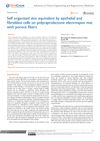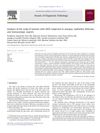Search
forLearn
5 / 6 resultslearn Osteopontin
signaling protein that, when suppressed, may grow hair by reducing inflammation and stem cell loss
learn Overview
learn Hair Multiplication
extract, clone, and reinsert your own hair cells
learn Stem Cell Factor
Research
5 / 1000+ resultsresearch P7 P63, K14 and P53 Expression in Epithelial Layers of Tumor-Distant Oral Mucosa in Patients with Oral Squamous Cell Carcinoma

research Self-Organized Skin Equivalent by Epithelial and Fibroblast Cells on Polycaprolactone Electrospun Mat with Porous Fibers
Researchers created a potential skin substitute using a biodegradable mat that supports skin cell growth and layer formation.
research Keratin Expression Provides Novel Insight Into the Morphogenesis and Function of the Companion Layer in Hair Follicles
Keratin patterns in hair follicles help understand hair growth and potential hair and nail disorders.

research Analysis of the Scalp of Women with AIDS Subjected to Autopsy: Epithelial, Follicular, and Immunologic Aspects
AIDS may cause changes in the scalp that increase infection risk and hair loss.
research FGF-9 Accelerates Epithelial Invagination for Ectodermal Organogenesis in Real-Time Bioengineered Organ Manipulation
FGF-9 speeds up the early development of certain organs, showing potential for organ regeneration.
Community Join
5 / 32 resultscommunity Is it possible for androgenic alopecia to begin at early adolescent years?
Hair loss can begin in early adolescence and cause mental anguish. Treatments mentioned include eating cruciferous vegetables, engaging in physical activity, and maintaining scalp hygiene.

community Minoxidil Response Bottlenecks: Why Sulfation and Transport Matter (And Where Tretinoin Fits In)
Minoxidil's effectiveness is limited by the need for sulfation and proper transport to hair follicles, with tretinoin potentially enhancing its effects by promoting enzyme activity and keratinocyte differentiation. Tretinoin may improve minoxidil's response by boosting the expression of necessary enzymes and transporters.

community Compressed part of research of theory of androgenic/anabolitic balance. AGA h-responders analytic. Theory of physio-metabolitic method of anti AGA treatment
The treatment for androgenetic alopecia involves using finasteride and minoxidil with intense exercise and cold exposure to boost metabolism and reduce androgenic effects, potentially leading to hair regrowth. This approach may activate biological pathways for improved hair and overall health.

community If You Have DUPA, PLEASE READ THIS: Everyone Should Be Scalp Biopsied
Scalp biopsies are crucial for diagnosing hair loss conditions like Diffuse Unpatterned Alopecia (DUPA) and retrograde hair loss, as treatments like finasteride and dutasteride may not be effective if other conditions are present. Combining PPAR-GAMMA agonists with retinoids could improve treatments for conditions like Lichen Planopilaris.
community Unpopular Opinion: hair cloning kind of sucks as a potential future cure.
Hair cloning is seen as a distant and potentially less relevant solution for hair loss due to its high cost, invasiveness, and the advancement of other treatments like Minoxidil and finasteride. Many believe that by the time hair cloning becomes viable, other less invasive and more effective treatments will be available.